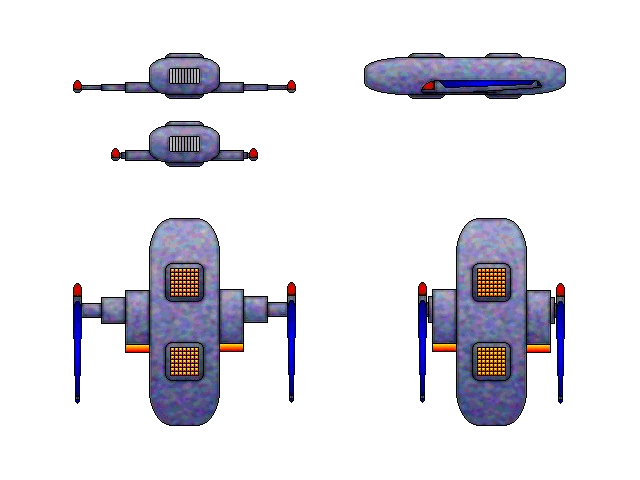

Los Angeles class
Inscription on commissioning plaque:
"Were we to give up half our territory rather than engage in a just
war to preserve it, we should not keep the other half long."
General Specifications:--Thomas Jefferson
Armaments: Eighteen phaser cannon (coupled to multifunction phased array), 72,000 enhanced quantum torpedoes, 24 squadrons of SARPEVs and 8 squadrons of fighters (4 light, 4 heavy).
Type: Battle Carrier (Self-Propelled Starbase)
Status: The Los Angeles is undergoing shakedown at this time. A further 7 Los Angeles class vessels will be constructed if Starfleet is satisfied with the results of testing. If Starfleet halts the Los Angeles class construction program, the Los Angeles will be re-designated a self-propelled starbase and used to support operations where a starbase is necessary but not available.
About Ship: The Dominion's successful use of small vessels in the recent conflict and the successful implementation of fighter vessels in the retaking of DS9 sparked a resurgence of interest in fighters. A carrier vessel would be required to support extensive fighter operations since small Federation vessels suitable as fighters have inadequate range for independent operations.
A number of interim designs were constructed. These were a mix of converted cargo vessels and existing capital ships adapted to the task. Both types had limited success. Cargo vessels had adequate internal volume easily configured for fighter operations, but often a complete revision of power generation and distribution systems was required before they were suitable as carriers. At first glance, exploration vessels seemed to offer plenty of internal volume for conversion, once exploration facilities were removed, but the amount of usable interior space is much less than the raw figures might indicate. Laboratory space aboard an exploration vessel is distributed throughout the spaceframe, each lab in proximity to the systems or sensors needed for a specialized task. Power requirements in support of fighter operations were at least adequate in most of these conversions.
Starfleet reluctantly agreed to commission a dedicated carrier, specifying a design tailored to the requirements and capabilities of the weapons systems to be carried. Since Starfleet had never commissioned this type of vessel before, the design team was assembled to include as many "lateral thinkers" as the Advanced Starship Design Bureau (ASDB) could identify. A third of the Los Angeles design team came from teams which had designed ships that would likely operate from it.
The exterior design of the Los Angeles is fairly simple, consisting of an ellipsoid shape with a straight-through flight deck. The deck openings (fore and aft), at 124 m x 64 m, are large enough to admit a Defiant class-sized vessel or smaller. The Los Angeles is expected to carry 80 fighters (4 squadrons of 12 standard fighters and 4 squadrons of 8 heavy fighters).
Each of the four blisters on the hull house launchers, storage, and maintenance areas for 18,000 enhanced quantum torpedoes and six squadrons (150) of SARPEVs. One or more blisters can be modified to provide maintenance and support for a cruiser or other similarly-sized vessel.
The Los Angeles is the largest vessel Starfleet has ever commissioned with variable geometry. This arrangement allows the Los Angeles to have a fairly high cruise velocity for a vessel its size. The primary advantage of this arrangement is the ability to expand the warp envelope so launched fighters can conserve energy by forming up under impulse power before leaving the mother ship's warp field. This is an important consideration, as most fighters have an effective radius measured in hours, rather than days or months.
The hull of the Los Angeles incorporates a multifunction phased array (MPA). All eighteen phaser cannon are coupled to this array. Shields are multilayered and rotate frequency at random intervals ranging from 2-70 nanoseconds. Beneath the MPA is a layer of ablative armor, which lies over more conventional hull materials. The hull is configured to reveal few cues to vulnerable areas. No external ports are visible apart from the flight deck launch/recovery doors. And the torpedo/SARPEV launch ports in the four blisters.
The Los Angeles has two main bridges. The first is the Command bridge.
This is the bridge from which all normal ship operations are directed.
The other bridge is the Flight bridge. All flight operations are directed
and coordinated from this bridge by the Flight Officer and up to 20 flight
coordinators. The Flight bridge consists of 20 flight coordinator stations
located in the center of a spherical holodeck. The holodeck provides overall
situational displays, supplemented by individual displays at each coordinator's
position. The Flight Officer's chair is located at the center where he may
easily observe and direct flight operations.
Return to the Starship Catalogue.